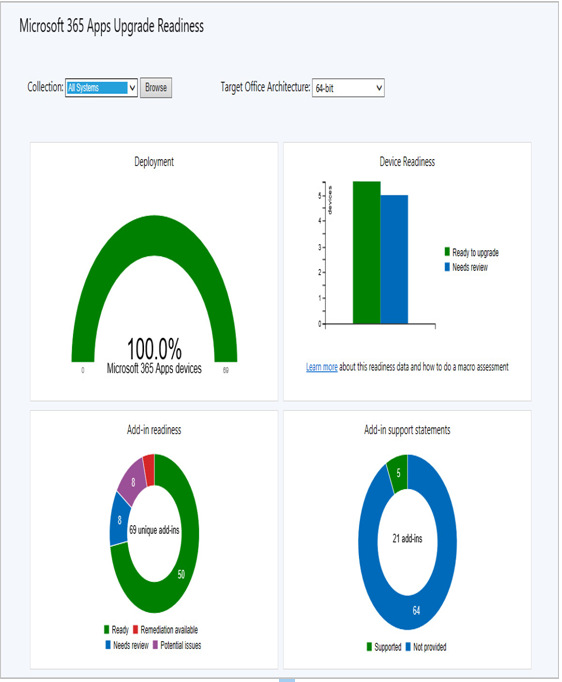The Office 365 Client Management dashboard, starting with Configuration Manager version 1802, is the go-to place for viewing information about the state of your Configuration Manager-deployed Office apps.
The dashboard shows a variety of health and configuration data for your managed devices. Beginning in version 1906, it also includes a Microsoft 365 Apps readiness dashboard, which is used to determine the readiness state when moving from Office 365 ProPlus to Microsoft 365 Apps, as shown in Figure 10.12:

Figure 10.12 – The Microsoft 365 Apps Upgrade Readiness dashboard
The Microsoft 365 Apps readiness dashboard includes several features specifically for understanding the readiness of add-ins and macros:
- Device readiness
- Add-in readiness
- Add-in support statements
- Top add-ins by the version count
- Number of devices that have macros
- Macro readiness
- Macro advisories
Each of these support areas will help you understand which devices, macros, and add-ins need to be remediated prior to upgrading to Microsoft 365 Apps.
Further reading
You can learn more about the Office 365 Client Management dashboard at https://learn.microsoft.com/en-us/mem/configmgr/sum/deploy-use/office-365-dashboard.
Whether you deploy Microsoft 365 apps via Microsoft Endpoint Manager (formerly Intune) or Configuration Manager, Microsoft provides a number of tools to use to configure, manage, and monitor your progress.
Summary
In this chapter, you learned about the tools and strategies for deploying Microsoft 365 apps to devices. For most organizations, Microsoft recommends creating a pilot group to ensure your organization can review and test upcoming releases.
Depending on your organization’s existing infrastructure, you can take several approaches to deploying Microsoft 365 apps to endpoints. Understanding the different paths to deployment is key to making sure you choose the right one for your scenario.
Next, we will learn about planning an Exchange Online deployment.
Knowledge check
In this section, we’ll test your knowledge of some key elements from this chapter.